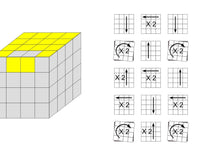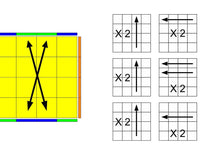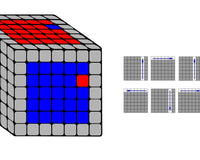Best Cube?...
You have mastered your last twisty puzzle and you are ready to take on the next challenge; but what puzzle should you learn to solve next? There are so many different types.
Well, of course there are no rules on what you can and can't buy next, but when browsing puzzles it may be useful to consider the level of difficulty and similarity compared to other puzzles you may already have.
For those beginning their speed-solving journey, the 3x3 or original Rubik's cube is highly recommended. This is because this cube is the foundation of speedcbbing as a whole. It is by far the most popular puzzle and uses concepts seen in many other puzzles. This means that if you can solve a 3x3, many other cubes will be significantly easier to learn.
Another thing about this cube is the huge variety of solving techniques, methods and tricks to be explored with it. There are always new challenges like the particular technique behind solving it blind-folded. Other puzzles of course have some variety in their solving techniques, but not quite as much as the 3x3.
After the 3x3 the next most popular puzzles are the 2x2, Pyraminx and Skewb. What makes these attractive to newer cubers is its simplicity whilst still requiring a new approach to the solution as they are still fundamentally different puzzles. Being familiar with the 3x3, you'll notice a good amount of similarity in the 2x2 and slightly less in the p[yraminx and skewb; because as you can see the axis on which the puzzles turn are completely different. It will take a short while to wrap your head around, but despite that they will all be relatively quick to learn because they require fewer steps and algorithms than the 3x3. In fact, some of the professional solvers in these events can take a single look at the cube and know their entire solution - start to finish. For those that hate the memorisation aspect for speed solving these puzzles are quick and easy to master. At least compared to some of the other puzzles that speed cubers commonly own.
Higher order cubic puzzles which include the 4x4, 5x5 and so on are also quite popular. These cubes appear to turn the same way as the 3x3, just that they have more layers to them. These higher order puzzles will add complexity to the 3x3 because new type of pieces are introduced. Take this 4x4 for example. A 3x3 has centres, edges and corners, but moving up to 4x4 you now have four times the number of centre pieces, which can also now move around; edges that can split into two, and regular corners. Higher order puzzles are good challenges for those wanting to take their skills a little bit further, however it is strongly recommended that you can solve a 3x3 cube first, before taking on the bigger guys.
A big misconception regarding these puzzles is that the higher order you go, the more difficult it becomes. After learning the 4x4 and 5x5 cubes; this is effectively not true because although more pieces must be solved, the process in which you solve them is the exact same as a 4x4 or 5x5. And so the solve will simply take longer rather than become more difficult.
Delving into the slightly less popular, but still common among speedcubers who compete in WCA competitions are puzzles like the Megaminx, Square-1 and Rubik’s clock. The megaminx is a 12-sided puzzle, adding a unique twist to speedsolving as have the other oddly shaped puzzles, but in regard to difficulty, is quite simple as the main concepts are very similar to that of the 3x3. Your competence as a 3x3 solver is closely linked to your ability to intuitively solve the megaminx. 3x3 knowledge alone will not allow you to solve the megaminx however as there are a just few new algorithms required for the last layer. The number of pieces makes this puzzle for some, a little tedious, but others enjoy the new possibilities it offers. The Square-1 and clock are typically some of the last puzzles that a speedcuber will come to learn. The turning restrictionsn of the square-1 makes it a difficult puzzle to solve and for both puzzles, the knowledge and experience gained from other cubes are virtually useless. They are kind of in their own lane in regard to theory and turning style, making them each one of the few puzzles that don’t complement the knowledge gained in any other puzzles. So for those speedcubers who have got the confidence and are up for the challenge, They are great puzzles to give a go.
Beyond all of the World Cube Association recognised puzzles, which naturally are most common among puzzle solvers, there are plenty of other twisty puzzles offering unique turning and different solving methods. You will find some puzzles that may look very complex but in fact aren’t, like the fisher and mirror cubes for example. They are 3x3 shape mods which means they fundamentally function exactly the same as a 3x3 but rather than using colours to identify a piece’s correct position, it uses a piece’s shape or appearance.
In summary, Twisty puzzles are preferred for a variety of reasons. Some, for their simplicity and popularity, like the 2x2, Pyraminx and Skewb. Some puzzles are a bit more difficult, but use familiar concepts to previous puzzles owned, like a 4x4 or a megaminx. And some puzzles are wanted for a challenge, like a square-1 or clock which are unique puzzles as they require unfamiliar concepts. Beyond the WCA puzzles you will find countless challenges. Cuboids, shape mods and other differently shaped puzzles with unique turning can bring new concepts into the twisty puzzle world, allowing you to really have fun with cubing, whether the puzzle be easy or hard.






5 commentaires
Joshuel
I have 11 cubes and I can solve all of them I’m the only one in my family that cans solve them🤣
ELA
Thanks now I know which cube I should get.
Rohith
Thanks now I know which cube to buy
Rohith
Thanks now I know which cube to buy
Toby Scott
My 4×4 is so good